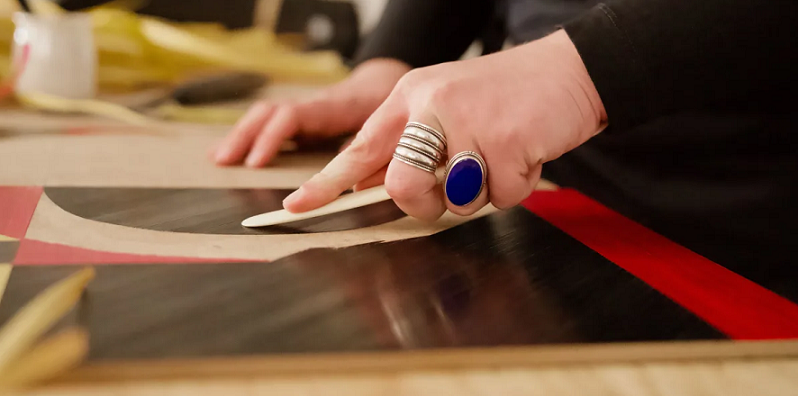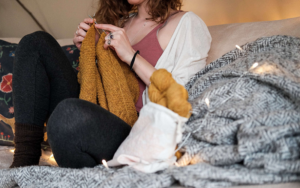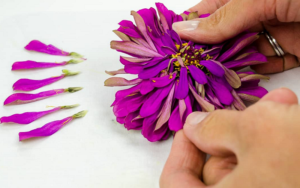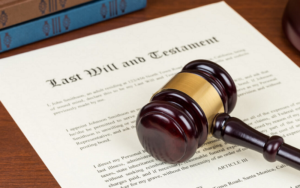
Straw marquetry, an ancient yet often overlooked art form, is making a resurgence in today’s environmentally conscious world. This sustainable and intricate craft showcases the beauty and versatility of a simple, natural material: straw. As the need for eco-friendly practices grows, straw marquetry stands out as an elegant and eco-conscious alternative to traditional wood marquetry.
What is Straw Marquetry?
Straw marquetry is a unique and delicate art form that involves creating intricate patterns and designs by applying carefully prepared straw pieces onto various surfaces. This craft, which finds its roots in ancient Egypt and Asia, has evolved over time, taking inspiration from traditional wood marquetry while distinguishing itself with its signature materials and sustainability.
Materials Used in Straw Marquetry
The primary material used in straw marquetry is, of course, straw. Different types of straw, such as rye, wheat, and oat, can be utilized depending on the desired color, thickness, and flexibility. Rye straw is often preferred for its exceptional quality and evenness.
To attach the straw pieces to the surface, various adhesives like natural glues and resins are employed. Apart from adhesives, other tools such as splitters, scissors, tweezers, and burnishers are essential in preparing and placing the straw pieces.
Comparison with Wood Marquetry
While straw marquetry shares several similarities with wood marquetry, there are notable differences. The most apparent distinction is the material itself: straw marquetry uses natural, renewable, and easily accessible straw, while wood marquetry relies on wood veneers, which can have a more significant ecological impact. The subtle sheen and texture of straw give the finished work a unique visual appeal, setting it apart from its wooden counterpart.
Straw Marquetry Techniques and Processes
The art of straw marquetry involves a series of meticulous techniques and processes, from the initial straw selection and preparation to the final assembly of intricate designs.
Harvesting and Preparation of Straw
The first step in straw marquetry is choosing the appropriate straw. Rye straw is often favored due to its uniform thickness, length, and durability. Harvesting the straw at the right time is crucial to ensure optimal quality, typically when the plant is mature but not overly dry.
Once the straw is harvested, it undergoes a drying process to remove any residual moisture, ensuring the straw remains stable and less prone to warping. Dyeing can be done at this stage if the desired color is not naturally available. Natural dyes are used to maintain the eco-friendly nature of the craft.
Design and Pattern Creation
Many straw marquetry designs draw inspiration from classic motifs and patterns found in wood marquetry, such as geometric shapes, floral elements, and intricate arabesques. Artisans often adapt these traditional patterns to highlight the unique qualities of straw.
Modern straw marquetry artists are pushing the boundaries by incorporating abstract, minimalist, and avant-garde designs. These innovations celebrate the versatility of straw, showcasing its potential in various artistic styles and applications.

Cutting and Assembling Techniques
To create fine, flexible pieces for marquetry, the straw must be split, flattened, and shaped. This process involves using specialized tools such as splitters, scissors, and burnishers. Each piece is carefully prepared to achieve the desired thickness and width, ensuring a seamless fit when assembled.
Once the straw pieces are prepared, they are carefully arranged and glued onto the desired surface according to the design. Natural adhesives such as animal glue, starch, or gum arabic are typically used. After the straw pieces are positioned, the surface is covered with a protective paper or cloth and pressed to ensure proper adhesion and a smooth finish.
Straw Marquetry Applications and Uses
The versatility and unique aesthetic of straw marquetry have led to its use in various applications, ranging from furniture decoration to functional objects and art installations.
Furniture Decoration and Restoration
Straw marquetry has long been used to adorn and embellish furniture pieces, including cabinets, tables, chairs, and chests. The intricate patterns and shimmering surface create a luxurious effect, adding value and visual appeal to the furniture. In restoration projects, straw marquetry can be used to repair or replace damaged wood marquetry, offering a sustainable and stunning alternative.
Wall Panels and Room Dividers
One of the more innovative applications of straw marquetry is in the creation of wall panels and room dividers. The lightweight and flexible nature of straw allows for large-scale installations that can transform interior spaces. These decorative elements can feature both traditional and contemporary designs, adding a touch of warmth and sophistication to any room.
Art Pieces and Installations
The artistic potential of straw marquetry has inspired many artists to create standalone art pieces and installations. From framed compositions to large-scale murals and sculptures, straw marquetry offers a unique medium for artistic expression. The natural sheen and subtle texture of straw add depth and dimension to these artworks, making them captivating and memorable.
Functional Objects (Jewelry Boxes, Frames, etc.)
Straw marquetry can also be applied to smaller functional objects, such as jewelry boxes, picture frames, and decorative trays. These pieces serve not only as practical items but also as beautiful works of art that showcase the artisan’s skill and craftsmanship. Such objects make for unique, thoughtful gifts and heirlooms, carrying the spirit of sustainability and artistry.

Straw Marquetry Sustainability and Environmental Benefits
In a world where environmental concerns are increasingly important, straw marquetry stands out as an eco-friendly and sustainable art form. Its use of natural, renewable materials, and low-impact processes make it an attractive choice for artisans, designers, and consumers who seek greener alternatives. In this section, we will explore the various sustainability and environmental benefits of straw marquetry.
Eco-friendly Material Sourcing
Straw is an abundant, renewable, and biodegradable material, making it a perfect choice for sustainable crafts. As a byproduct of cereal crops like rye, wheat, and oat, straw is widely available and can be sourced locally, reducing transportation-related carbon emissions. The use of natural dyes and adhesives further contributes to the eco-friendliness of straw marquetry.
Reduction in Wood Consumption
By using straw as an alternative to wood veneers in marquetry, artists and designers can help reduce the demand for wood, which is often sourced from endangered forests and ecosystems. This decrease in wood consumption has a positive impact on global deforestation rates and helps promote better forest management practices. Straw marquetry is a suitable restoration technique for damaged wood marquetry, offering a sustainable solution that preserves the original design while minimizing environmental impact.
Biodegradable and Recyclable End Products
Straw marquetry products are composed of organic materials that can be composted or recycled, reducing waste in landfills and lowering their environmental footprint. When properly cared for, straw marquetry pieces can last for generations, becoming heirlooms that can be passed down and cherished for their beauty and craftsmanship. However, when their lifespan eventually comes to an end, these pieces can be responsibly disposed of without causing significant harm to the environment.

Learning Straw Marquetry
As interest in sustainable crafts and eco-friendly art forms grows, more and more people are seeking to learn and master the art of straw marquetry. Fortunately, there are various avenues to explore for those who wish to develop their skills in this intricate and rewarding craft.
Workshops and Classes
One of the best ways to learn straw marquetry is by attending hands-on workshops and classes led by experienced artisans. These in-person sessions provide an opportunity to learn the techniques and processes directly from experts, receive personalized guidance, and practice under their supervision. Many cities have art centers, craft schools, or specialized studios that offer straw marquetry workshops or courses for beginners and advanced learners.
Online Tutorials and Resources
For those who prefer learning at their own pace or do not have access to local workshops, online tutorials and resources can be an excellent alternative. Numerous websites, blogs, and video platforms offer step-by-step instructions and demonstrations covering various aspects of straw marquetry, from basic techniques to advanced projects. Some experienced straw marquetry artists also offer paid online courses, providing more structured learning experiences and opportunities for personalized feedback.
Tips for Beginners
Starting your journey in straw marquetry can be both exciting and challenging. Here are some tips to help beginners navigate the learning process:
- Invest in quality tools and materials: Having the right tools and materials is essential for successful straw marquetry projects. Invest in high-quality straw, adhesives, and specialized tools like splitters, burnishers, and tweezers to ensure the best possible results.
- Practice patience and precision: Straw marquetry is a meticulous art form that requires patience, precision, and a steady hand. Take your time when learning new techniques, and practice regularly to improve your skills and increase your confidence.
- Start with simple designs: Begin with straightforward designs and patterns to familiarize yourself with the techniques and materials. As you gain experience and confidence, gradually move on to more complex and intricate projects.
- Seek guidance and inspiration: Connect with other straw marquetry enthusiasts, join online forums, or follow artists on social media to share your progress, ask questions, and find inspiration. Engaging with a community of like-minded individuals can be highly motivating and beneficial for your learning journey.







